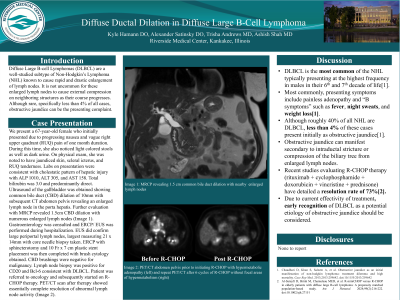Tuesday Poster Session
Category: Biliary/Pancreas
P3502 - Diffuse Ductal Dilation in Diffuse Large B-Cell Lymphoma
Tuesday, October 29, 2024
10:30 AM - 4:00 PM ET
Location: Exhibit Hall E

Has Audio

Kyle Hamann, DO
Riverside Medical Center
Kankakee, IL
Presenting Author(s)
Kyle Hamann, DO, Trisha Andrews, MD, Ashish Shah, MD
Riverside Medical Center, Kankakee, IL
Introduction: Diffuse Large B-cell Lymphomas (DLBCL) are a well-studied subtype of Non-Hodgkin’s Lymphoma(NHL) known to cause rapid and drastic enlargement of lymph nodes. It is not uncommon for these enlarged lymph nodes to cause external compression on neighboring structures as their course progresses. Although rare, less than 4% of all cases, obstructive jaundice can be the presenting complaint.
Case Description/Methods: We present a 67-year-old female who initially presented due to progressing nausea and vague right upper quadrant (RUQ) pain of one month duration. During this time, she also noticed light colored stools as well as dark urine. On physical exam, she was noted to have jaundiced skin, scleral icterus, and RUQ tenderness. Labs on presentation were consistent with cholestatic pattern of hepatic injury with ALP 1010, ALT 305, and AST 158. Total bilirubin was 3.0 and predominantly direct. Ultrasound of the gallbladder was obtained showing common bile duct (CBD) dilation of 10mm with subsequent CT abdomen pelvis revealing an enlarged lymph node in the porta hepatis. Further evaluation with MRCP revealed 1.5cm CBD dilation with numerous enlarged lymph nodes. Gastroenterology was consulted with ERCP/ EUS performed. EUS did confirm large periportal lymph nodes, largest measuring 21 x 14mm with core needle biopsy taken. ERCP with sphincterotomy and 10 Fr x 7 cm plastic stent placement was then completed with brush cytology. CBD brushings were negative for malignancy. Lymph node biopsy was positive for CD20 and Bcl-6 consistent with DLBCL. Patient was referred to oncology and subsequently started on R-CHOP therapy. PET/CT scan after therapy showed essentially complete resolution of abnormal lymph node activity.
Discussion: DLBCL is the most common of the NHL typically presenting at the highest frequency in males in their 6th and 7th decade of life. Most commonly, presenting symptoms include painless adenopathy and “B symptoms” such as fever, night sweats, and weight loss. Although roughly 40% of all NHL are DLBCL, less than 4% of these cases present initially as obstructive jaundice. Obstructive jaundice can manifest secondary to intraductal stricture or compression of the biliary tree from enlarged lymph nodes. Recent studies evaluating R-CHOP therapy have detailed a resolution rate of 73%. Due to current effectivity of treatment, early recognition of DLBCL as a potential etiology of obstructive jaundice should be considered.

Disclosures:
Kyle Hamann, DO, Trisha Andrews, MD, Ashish Shah, MD. P3502 - Diffuse Ductal Dilation in Diffuse Large B-Cell Lymphoma, ACG 2024 Annual Scientific Meeting Abstracts. Philadelphia, PA: American College of Gastroenterology.
Riverside Medical Center, Kankakee, IL
Introduction: Diffuse Large B-cell Lymphomas (DLBCL) are a well-studied subtype of Non-Hodgkin’s Lymphoma(NHL) known to cause rapid and drastic enlargement of lymph nodes. It is not uncommon for these enlarged lymph nodes to cause external compression on neighboring structures as their course progresses. Although rare, less than 4% of all cases, obstructive jaundice can be the presenting complaint.
Case Description/Methods: We present a 67-year-old female who initially presented due to progressing nausea and vague right upper quadrant (RUQ) pain of one month duration. During this time, she also noticed light colored stools as well as dark urine. On physical exam, she was noted to have jaundiced skin, scleral icterus, and RUQ tenderness. Labs on presentation were consistent with cholestatic pattern of hepatic injury with ALP 1010, ALT 305, and AST 158. Total bilirubin was 3.0 and predominantly direct. Ultrasound of the gallbladder was obtained showing common bile duct (CBD) dilation of 10mm with subsequent CT abdomen pelvis revealing an enlarged lymph node in the porta hepatis. Further evaluation with MRCP revealed 1.5cm CBD dilation with numerous enlarged lymph nodes. Gastroenterology was consulted with ERCP/ EUS performed. EUS did confirm large periportal lymph nodes, largest measuring 21 x 14mm with core needle biopsy taken. ERCP with sphincterotomy and 10 Fr x 7 cm plastic stent placement was then completed with brush cytology. CBD brushings were negative for malignancy. Lymph node biopsy was positive for CD20 and Bcl-6 consistent with DLBCL. Patient was referred to oncology and subsequently started on R-CHOP therapy. PET/CT scan after therapy showed essentially complete resolution of abnormal lymph node activity.
Discussion: DLBCL is the most common of the NHL typically presenting at the highest frequency in males in their 6th and 7th decade of life. Most commonly, presenting symptoms include painless adenopathy and “B symptoms” such as fever, night sweats, and weight loss. Although roughly 40% of all NHL are DLBCL, less than 4% of these cases present initially as obstructive jaundice. Obstructive jaundice can manifest secondary to intraductal stricture or compression of the biliary tree from enlarged lymph nodes. Recent studies evaluating R-CHOP therapy have detailed a resolution rate of 73%. Due to current effectivity of treatment, early recognition of DLBCL as a potential etiology of obstructive jaundice should be considered.

Figure: a) BCL2; b) BCL6; c) MYC
Disclosures:
Kyle Hamann indicated no relevant financial relationships.
Trisha Andrews indicated no relevant financial relationships.
Ashish Shah indicated no relevant financial relationships.
Kyle Hamann, DO, Trisha Andrews, MD, Ashish Shah, MD. P3502 - Diffuse Ductal Dilation in Diffuse Large B-Cell Lymphoma, ACG 2024 Annual Scientific Meeting Abstracts. Philadelphia, PA: American College of Gastroenterology.

